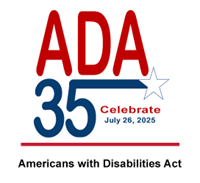35th Anniversary of the Signing of the Americans with Disabilities Act (ADA)

By Justine Chichester
The Americans with Disabilities Act (ADA) was signed into law 35 years ago on July 26, 1990. This historic law protects the rights of people living with disabilities and has transformed the landscape of civil rights in the United States.
What is the ADA?
The Americans with Disabilities Act (ADA) was signed into law, by President George W. Bush. This piece of legislation prohibits discrimination against individuals with disabilities in all areas of public life – jobs, schools, transportation and all places that are open to the general public.
Background
Before the ADA, Americans living with disabilities faced significant barriers in everyday life. Inaccessible public transportation, lack of accommodations in education and employment, and exclusion from community spaces were common. The disability rights movement, powered by decades of grassroots activism, fought for inclusion and equality, culminating in the passage of the ADA.
Key Provisions of the ADA
The ADA is divided into five titles:
Title I – Employment: Prohibits discrimination in the workplace and requires reasonable accommodations for qualified employees with disabilities.
Title II – Public Services: Mandates that state and local governments give people living with disabilities equal opportunity to benefit from public programs and services.
Title III – Public Accommodations: Requires privately owned businesses and facilities (such as restaurants, hotels and theaters) to be accessible.
Title IV – Telecommunications: Requires telephone and internet companies provide services that allow people with hearing or speech disabilities to communicate.
Title V – Miscellaneous Provisions: Includes technical provisions and protections against retaliation and coercion against individuals living with disabilities or those attempting to aid people living with disabilities in asserting their rights under the ADA.
Impact Over 35 Years and The Challenges That Remain
Since its enactment, the ADA has dramatically improved accessibility and inclusion, including ramps, curb cuts, accessible bathrooms and elevators becoming standard in many buildings; millions of people living with disabilities have gained access to job opportunities due to workplace inclusion and reasonable accommodations; digital spaces, such as websites and mobile apps are widely being more and more included in the interpretation of the ADA; and a generally, broader understanding of disability as a civil rights issue rather than a medical or charitable one.
However, there are still many challenges that remain. As of 2024, the labor force participation rate for people living with disabilities was 23%, compared to 67% for people living without disabilities. Many websites and digital tools remain difficult to navigate for people living with vision or mobility impairments. While the law prohibits discrimination, enforcement can be slow or uneven without active monitoring or litigation.
Looking Towards the Future
The ADA’s 35th anniversary is not just a celebration – it is a call for all of us to continue the work. With emerging technologies, changing workplaces and ongoing inequality, many disability rights advocates are focusing on:
- Inclusive design in AI and technology
- Expanding employment initiatives
- Improving healthcare and education
- Strengthening enforcement and modernization of ADA standards
While the ADA reshaped the American society for the better by enabling millions living with disabilities to participate more fully in everyday life, we can use this celebration of it’s signing to recommit ourselves to the ADA’s vision – A nation where every individual, regardless of ability, can live with dignity, opportunity and independence.
Disability Independence Group has played a crucial role in advancing the mission of the ADA by advocating for equal rights, access and opportunities for people living with disabilities. From programs in education, such as our trainings; support services such as our Wallet Card Project; public outreach, such as our Supper Social Club; and legal advocacy throughout the years, DIG has worked tirelessly to break down barriers that can prevent full inclusion in society. By collaborating with businesses, first responders and policy makers, DIG helps create more accessible and inclusive environments, which aligns with the ADA’s goal of promoting independence, dignity and full participation in all aspects of life.













